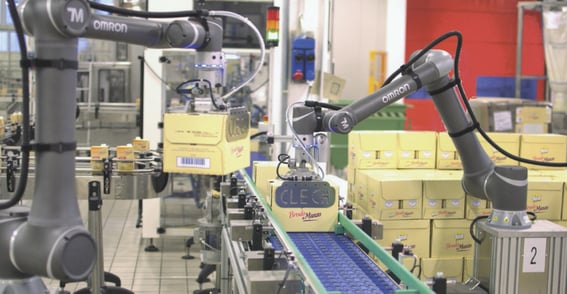How are industrial cobots revolutionizing the workplace? These collaborative robots are not just futuristic concepts; they are actively enhancing operational efficiency and human-robot collaboration today. Join us as we unpack the role of cobots in key industries, their indispensable safety protocols, and their impact on the workforce, without giving away the following comprehensive analysis.
Jump to a Section
Understanding Cobots | Essential Safety Measures | Collaborative Robot Applications | Advantages of Implementing Cobots | Popular Cobot Brands and Models | Tools and Accessories for Cobots | Programming, Customization and Cost of Cobots | Real-World Success | Frequently Asked Question
Key Takeaways✔️ Cobots, or collaborative robots, are designed to work alongside humans, enhancing safety and efficiency by handling repetitive tasks so humans can focus on complex work.
|
Understanding Cobots: The Basics

What exactly is an industrial cobot? Well, imagine a robot that can work hand-in-hand with humans, safely and efficiently. That’s a cobot for you! Unlike traditional industrial robots, collaborative robots are designed to interact with humans in a shared workspace. They’re smaller, safer, and more adaptable, designed to fit in tight spaces and ensure safe interaction with their human colleagues.
Compared to traditional cobot robots, industrial robots are less flexible and require more safety precautions. But cobots aren’t just about safety. They’re about productivity and problem-solving, too. While handling repetitive, mundane tasks, human workers can focus on more complex, creative tasks. This unique blend of human and robot capabilities has made cobots a game-changer in the business world, boosting production efficiency and financial performance across various industries. Learn more about cobots in our blog post, "What is a Collaborative Robot?"
Essential Safety Measures for Collaborative Robots
Safety is the hallmark of cobots. They offer several safety features, including:
- Smooth edges
- Lightweight
- Limited force exertion
- Built-in sensors
These sensors detect unexpected forces and prompt the collaborative robot to slow down or stop, preventing accidents and keeping its human operators and coworkers safe.
.
 But that’s not all. Cobots also employ advanced technologies like camera and vision systems, torque sensors, and machine learning to ensure safe operation. They even use sensors and screens to monitor human proximity, maintaining a safe level of human-robot interaction critical for various collaborative robot applications. Are you interested in learning more about cobot safety? Watch our on-demand webinar, "Myth-Busting Cobot Safety."
But that’s not all. Cobots also employ advanced technologies like camera and vision systems, torque sensors, and machine learning to ensure safe operation. They even use sensors and screens to monitor human proximity, maintaining a safe level of human-robot interaction critical for various collaborative robot applications. Are you interested in learning more about cobot safety? Watch our on-demand webinar, "Myth-Busting Cobot Safety."
Collaborative Robot Applications Across Industries
 Cobots are incredibly versatile, adaptable to different operational needs, and capable of working alongside human workers across various sectors. From manufacturing to logistics to education, collaborative robots are making their mark, handling tasks like assembly, machine tending, and even hands-on learning in STEM education. Let’s examine the transformation cobots are bringing to these industries.
Cobots are incredibly versatile, adaptable to different operational needs, and capable of working alongside human workers across various sectors. From manufacturing to logistics to education, collaborative robots are making their mark, handling tasks like assembly, machine tending, and even hands-on learning in STEM education. Let’s examine the transformation cobots are bringing to these industries.
Manufacturing

In the manufacturing industry, collaborative robots are redefining efficiency and productivity. They handle tasks accurately, from soldering and welding to delicate electronics testing and quality control. In the automotive sector, cobots are gaining popularity due to their customization capabilities and ability to handle smaller series sizes. In the pharmaceutical sector, cobots are minimizing errors, and advanced gripper technology has revolutionized food handling processes in the food industry.
The result? Increased productivity, improved product quality, and a happier workforce. For instance, Athena saw a significant increase in part production after implementing the FANUC CRX cobot, a testament to the transformative power of cobots in the manufacturing industry.
Logistics

In the logistics sector, collaborative robots are proving to be game-changers. They enhance material handling, reducing order fulfillment times significantly. They also streamline transportation processes, making them more efficient, safer, and more flexible.
But cobots don’t stop there. They also assist with inventory management, improving operational efficiency and accuracy, and minimizing physical interaction with human workers. Real-world examples like DHL using cobots in their warehouses underscore the significant difference cobots make in the logistics industry compared to traditional industrial robots.
Education
 Stepping out of the industrial sector, collaborative robots are also making their way into classrooms. They’re being introduced as practical tools for STEM application students, providing hands-on learning experiences that connect theoretical knowledge with real-life applications.
Stepping out of the industrial sector, collaborative robots are also making their way into classrooms. They’re being introduced as practical tools for STEM application students, providing hands-on learning experiences that connect theoretical knowledge with real-life applications.
For instance, students like Mikaela Domingo can now program and use an Omron TM Collaborative Robot in their daily activities, exploring various collaborative robot application possibilities with collaborative robots. This interactive learning not only makes education more engaging but also prepares students for future tech-focused jobs, all while ensuring human safety.
Check out our Life Science lading page for life science examples of successful cobot use.
Advantages of Implementing Cobots

What benefits can we expect from implementing cobots? For starters, cobots offer flexible automation, meaning they can be easily moved around to different jobs without having to change the entire production setup. This adaptability is one of the reasons behind the rapid growth of the collaborative robot market.
Moreover, collaborative robots are designed with user-friendly features that make them easy to program, leading to fast setup times. For example, Universal Robots offers free online training for programming basic cobot automation processes, with additional modules available for more advanced tasks. And let’s not forget the improved safety for human workers, thanks to cobots’ ability to take on repetitive tasks and reduce accidental injuries. Are you interested in learning how to use a cobot? Check out our Free Virtual Training: Cobot Safety.
Popular Cobot Models by Omron
With the rise in cobot applications, Omron has emerged as a key player. Omron offers a variety of models catering to different needs, all designed to minimize direct physical interaction with human workers.
Tools and Accessories for Cobots

Collaborative robots are not standalone tools. They often come equipped with a variety of accessories to amplify their capabilities, including:
- Grippers
- End of Arm Tooling (EOAT)
- Cameras
- Force torque sensors
Grippers, for example, enable collaborative robots to handle objects, providing lifting force and reducing vibration and noise. These various tools and accessories not only expand the functionality of cobots but also increase their safety and efficiency.
Cobot Gripper Partners
Programming and Customization of Cobots
The ease of programming and customization adds to the appeal of cobots. Unlike traditional robots, cobots have user-friendly tools like apps and software that work on smartphones and desktops, making installation and programming a breeze.
What’s more? Collaborative robots can be easily adapted to take on new tasks as industrial processes evolve. This flexibility and their easy programming allow for quick implementation and adaptation, making them a valuable asset in various industries.
Cost Considerations for Cobot Implementation
 Like any business decision, cost plays a significant role when contemplating the cost-effective implementation of cobots. While the startup expenses and maintenance can vary depending on the application and system, it’s important to note that the benefits often outweigh the initial costs.
Like any business decision, cost plays a significant role when contemplating the cost-effective implementation of cobots. While the startup expenses and maintenance can vary depending on the application and system, it’s important to note that the benefits often outweigh the initial costs.
When budgeting for cobot implementation, businesses need to consider the initial purchase and setup costs and ongoing expenses such as maintenance, software support, upgrades, labor hours, and power usage. All these factors contribute to the total cost of ownership and should be carefully considered before deciding.
Addressing Workforce Concerns and Cobots
Employees may naturally have concerns about collaborative robots entering their workspace. However, it’s important to emphasize that cobots are designed to assist humans, not replace them. Cobots can improve overall job satisfaction by taking over physically strenuous and repetitive tasks.
![]() Furthermore, contrary to popular belief, the introduction of cobots has actually helped to increase employment rates in advanced economies. With the appropriate training, a human worker can work safely and effectively alongside cobots, enhancing productivity and job satisfaction for human workers.
Furthermore, contrary to popular belief, the introduction of cobots has actually helped to increase employment rates in advanced economies. With the appropriate training, a human worker can work safely and effectively alongside cobots, enhancing productivity and job satisfaction for human workers.
Real-World Success Stories
Real-world success stories provide the most tangible understanding of the impact of cobots, a type of industrial robot with a robot arm, in a production environment. Take Allied Moulded Products Inc., for example. They used the Universal Robots’ ActiNav Autonomous Bin-Picking Kit, provided by a robotic integration company, to overcome labor shortages and saw significant productivity improvements.
Then there’s Thyssenkrupp Bilstein, which experienced smoother automation, consistent quality, cost savings, and increased production efficiency after implementing cobots. These stories highlight the transformative power of cobots across various industries, proving that they’re not just a futuristic concept, but a present reality.
 In a nutshell, cobots are revolutionizing the world of automation, offering numerous benefits, from increased productivity and safety to flexible automation and easy programming. They’re used across various industries, from manufacturing to logistics to education, enhancing operational efficiency and job satisfaction.
In a nutshell, cobots are revolutionizing the world of automation, offering numerous benefits, from increased productivity and safety to flexible automation and easy programming. They’re used across various industries, from manufacturing to logistics to education, enhancing operational efficiency and job satisfaction.
With their unique features and user-friendly design, cobots are not just the future of automation - they’re the present, transforming how we work and paving the way for a brighter, more efficient future.








Leave Comment